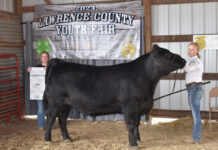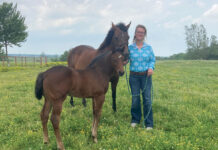
In 2000 the potential of Ron Locke’s farm, in Long Lane, Mo., grew exponentially after he attended the Annual Southwest Missouri Spring Forage conference in Springfield, Mo., where Ron first learned about intensive grazing.
“After the conference I contacted my local NRCS office and attended grazing school where I got help designing my plan. I had to wait several months for an opening in grazing school but it was the best thing I ever did,” recalled Ron.
Today, Ron has divided his 400-acre farm into an efficient intensive grazing system for his registered Angus and commercial cattle herd. “My goal is to have a grazing system that supports my cattle year-round. I am not there yet but we are getting closer. In order to accomplish this I need more warm-season grasses and to continue to eliminate the Kentucky 31 Fescue,” explained Ron.
Ron has been reseeding his pastures for the past six or seven years. He reseeds 20 acres per year but the drought has slowed his progress. His plans are to restart the pasture renovation mid-May 2014.
When considering which paddocks to reseed Ron asks himself, “Can I afford to take this paddock out of production this year, long enough to replant?” In each 20-acre paddock Ron primarily seeds in MaxQ Tall Fescue, BarOptima Plus 34 Fescue, Gainer III clover, as well as, warm-season crops like gamagrass and spring peas.
One challenge Ron faces when converting pastures is taking pastures out of productivity. One paddock is used for both breeding and weaning, so it would be inconvenient to take it out of production. Ron has yet to figure out a way to make it work.
Ron has converted two pastures into warm-season grasses for summer grazing. His cow/calf pairs will strip graze each field three times during the summer. The summer pasture is planted in gamagrass, which needs to be grazed down completely. In the hottest part of the summer (July-August) gamagrass will grow an inch per day. However, this year for the first time Ron drilled spring peas into one field with the gamagrass in mid-February – early March. “I’ve been told by grasslands specialists that there is a microbial benefit of using gamagrass with spring peas,” explained Ron.
Ron uses an above ground poly water pipe along with a 100-gallon water tank that is moved as the strip grazing is moved.
“Last year I was only able to graze this field two and a half times before we ran out of moisture so I had to move the cows. I am careful when grazing this field in the summer. If temperature reaches about 90 degrees with 80 percent humidity I move the cows to a more shaded field,” added Ron.
Ron also strip grazes during the winter months, typically starting after Christmas until green-up time.
Ron has seen many benefits from converting his farm into an intensive grazing system including soil improvement, forage improvement, reduced hay usage, decreased fertilizer need, decreased fencing cost and improved weed control.
“Myron Hartzell, Dallas County NRCS grasslands specialist, taught me years ago you can control weeds with grazing. I find myself constantly taking measurements with a plate meter and walking my fields. If I see weeds coming up as I walk across my fields that is a good indicator it’s time to move cows. Cows will eat just about any weed at the early stages of growth.
“I used to spray for weeds. Until 2005, if there were weeds I was spraying. Now I save a lot of money because I only spot spray,” justified Ron.
One other cost saving technique with intensive grazing is with fence costs. “I didn’t know any better. Fence cost alone has decreased. I found out you don’t need all the wires and posts,” said Ron.
Since switching his grazing system Ron has went from feeding 350 bales each winter to feeding around 100 bales. All of his hay is inventoried and tested to ensure each group of cattle are being fed exactly what they need.
Ron’s grazing system is in place to support his registered Black Angus and commercial herd. There isn’t an exact science to intensive grazing. Ron concluded it is as simple as, “looking at the grass. When the grass is ready, I move cows.”







